379. NYC Photo Journal: Long Island City Part 1/ P.S.1
This is an area across the East River from Manhattan on the Queens side. It was once run-down and industrial but as years go by and areas become gentrified the face of the city changes. This area is soon to be unaffordable.
I’ll start the tour at P.S. 1. (Public School) P.S. 1 was built in the 1800’s and is no longer used as a school. It has become a contemporary arts center where artists have their own studios in classrooms.
About
P.S.1 Profile
P.S.1 Contemporary Art Center is one of the oldest and largest non-profit contemporary art institutions in the United States. An exhibition space rather than a collecting institution, P.S.1 devotes its energy and resources to displaying the most experimental art in the world. A catalyst and an advocate for new ideas, discourses, and trends in contemporary art, P.S.1 actively pursues emerging artists, new genres, and adventurous new work by recognized artists in an effort to support innovation in contemporary art. P.S.1 achieves this mission by presenting its diverse program to a broad audience in a unique and welcoming environment in which visitors can discover and explore the work of contemporary artists. P.S.1 presents over 50 exhibitions each year, including artists’ retrospectives, site-specific installations, historical surveys, arts from across the United States and the world, and a full schedule of music and performance programming.
P.S.1 was founded in 1971 by Alanna Heiss as the Institute for Art and Urban Resources Inc., an organization devoted to organizing exhibitions in underutilized and abandoned spaces across New York City. In 1976, P.S.1 opened its first major exhibition in its permanent location in Long Island City, Queens, with the seminal Rooms exhibition. An invitation for artists to transform the building’s unique spaces, Rooms established the P.S.1 tradition of transforming the building’s spaces into site-specific art that continues today with long-term installations by James Turrell, Keith Sonnier, Richard Serra, Lawrence Weiner, and others.
For the next twenty years, the building was used as studio, performance, and exhibition spaces, in support of artists from around the world. After a building-wide renovation, P.S.1 reopened in 1997, confirming its position as the leading contemporary art center in New York. True to the building’s history and form, the renovation preserved much of the original architecture as well as most of its unique classroom-sized galleries.
In 2000, P.S.1 became an affiliate of the Museum of Modern Art to extend the reach of both institutions, and combine P.S.1’s contemporary mission with MoMA’s strength as one of the greatest collecting museums of modern art.
A true artistic laboratory, P.S.1 aspires to maintain its diverse and innovative activities to continue to bring contemporary art to international audiences.
As we approach the entrance we see strange, hairy, teepee shapes in the yard; they are actually creating cooling through condensation. As one walks through and under there’s a feeling of cool light rain.
Unfortunately, one isn’t allowed to take photographs in the galleries, but there is something of great fun that I will share; Leonardo Erlich’s “Swimming Pool.” Erlich is famous for this installation which appears to defy the laws of physics.
When you first look at the pool, it seems like you can jump right in. So what’s the big deal? Upon closer examination you can see intermittent shapes in the water; people! Ok, look closer. The pool is actually about 2 inches of water on top of plexiglass. A flight below the “deck” is the pool interior, sans water, where people walk or playfully do a pseudo swim. Looking down into the pool or up from it, it becomes an interesting joke. We’ve been duped and we love it.
Part 2 links here
Views: The yard, from P.S. 1 windows at skyline and 59th Street Bridge, the Pool.


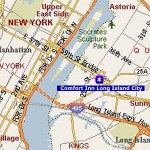
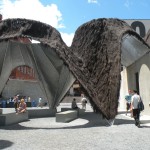

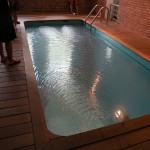
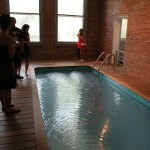
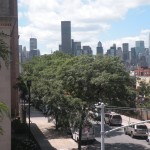
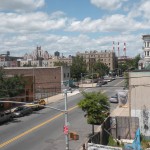
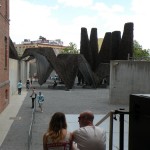
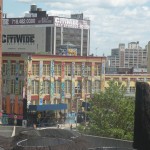
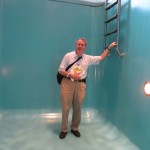
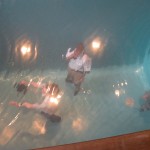
Comments
379. NYC Photo Journal: Long Island City Part 1/ P.S.1 — No Comments
HTML tags allowed in your comment: <a href="" title=""> <abbr title=""> <acronym title=""> <b> <blockquote cite=""> <cite> <code> <del datetime=""> <em> <i> <q cite=""> <s> <strike> <strong>